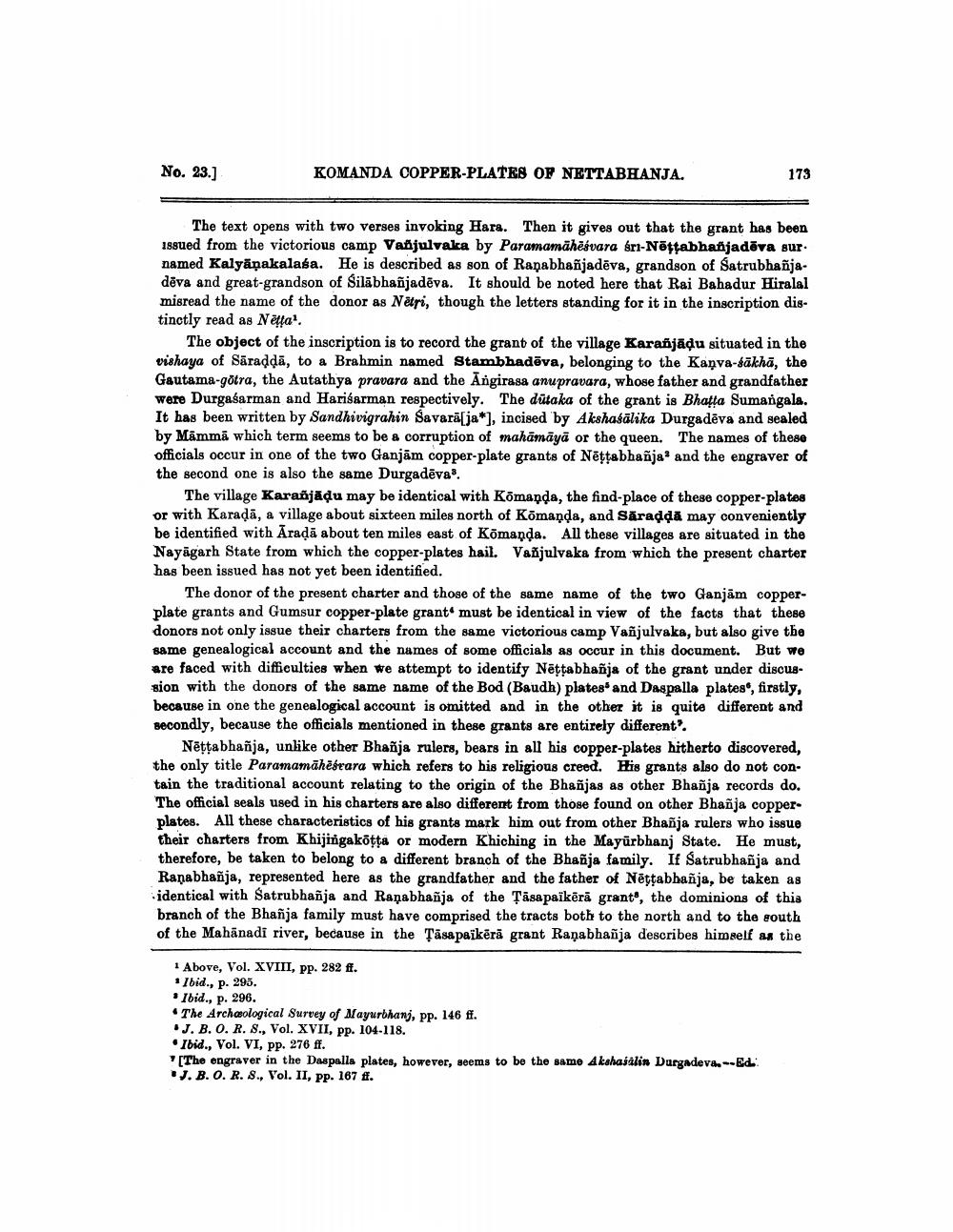________________
No. 23.]
KOMANDA COPPER-PLATES OF NETTABHANJA.
173
The text opens with two verses invoking Hara. Then it gives out that the grant has been Issued from the victorious camp Vañjulvaka by Paramamaheśvara śri-Nettabhañjadēva sur. named Kalyapakalasa. He is described as son of Ranabhañjadēva, grandson of Satrubhañjadeva and great-grandson of Silabhañjadeva. It should be noted here that Rai Bahadur Hiralal misread the name of the donor as Netri, though the letters standing for it in the inscription distinctly read as Netta'.
The object of the inscription is to record the grant of the village Karañjāḍu situated in the vishaya of Sāraḍḍā, to a Brahmin named Stambhadēva, belonging to the Kaṇva-śākhā, the Gautama-götra, the Autathya pravara and the Angirasa anupravara, whose father and grandfather were Durgasarman and Harisarman respectively. The dutaka of the grant is Bhatta Sumangala. It has been written by Sandhivigrahin Savara[ja*], incised by Akshasalika Durgadeva and sealed by Mamma which term seems to be a corruption of mahāmāyā or the queen. The names of these officials occur in one of the two Ganjam copper-plate grants of Neṭṭabhañja and the engraver of the second one is also the same Durgadeva3.
The village Karanjaḍu may be identical with Kōmanda, the find-place of these copper-plates or with Karada, a village about sixteen miles north of Kōmaṇḍa, and Săraḍḍā may conveniently be identified with Araḍā about ten miles east of Kōmanda. All these villages are situated in the Nayagarh State from which the copper-plates hail. Vañjulvaka from which the present charter has been issued has not yet been identified.
The donor of the present charter and those of the same name of the two Ganjam copperplate grants and Gumsur copper-plate grant must be identical in view of the facts that these donors not only issue their charters from the same victorious camp Vañjulvaka, but also give the same genealogical account and the names of some officials as occur in this document. But we are faced with difficulties when we attempt to identify Neṭṭabhañja of the grant under discussion with the donors of the same name of the Bod (Baudh) plates and Daspalla plates, firstly, because in one the genealogical account is omitted and in the other it is quite different and secondly, because the officials mentioned in these grants are entirely different?.
Nēṭṭabhañja, unlike other Bhañja rulers, bears in all his copper-plates hitherto discovered, the only title Paramamahēsvara which refers to his religious creed. His grants also do not contain the traditional account relating to the origin of the Bhañjas as other Bhañja records do. The official seals used in his charters are also different from those found on other Bhañja copperplates. All these characteristics of his grants mark him out from other Bhañja rulers who issue their charters from Khijingakōṭṭa or modern Khiching in the Mayurbhanj State. He must, therefore, be taken to belong to a different branch of the Bhañja family. If Satrubhañja and Ranabhañja, represented here as the grandfather and the father of Neṭṭabhañja, be taken as identical with Satrubhañja and Ranabhañja of the Tasapaïkērā grant", the dominions of this branch of the Bhañja family must have comprised the tracts both to the north and to the south of the Mahanadi river, because in the Tasapaikērā grant Ranabhañja describes himself as the
1 Above, Vol. XVIII, pp. 282 ff.
Ibid., p. 295.
Ibid., p. 296.
The Archaeological Survey of Mayurbhanj, pp. 146 ff.
J. B. O. R. S., Vol. XVII, pp. 104-118.
Ibid., Vol. VI, pp. 276 ff.
[The engraver in the Daspalla plates, however, seems to be the same Akshasalin Durgadeva.--Ed J. B. O. R. S., Vol. II, pp. 167 ff.




